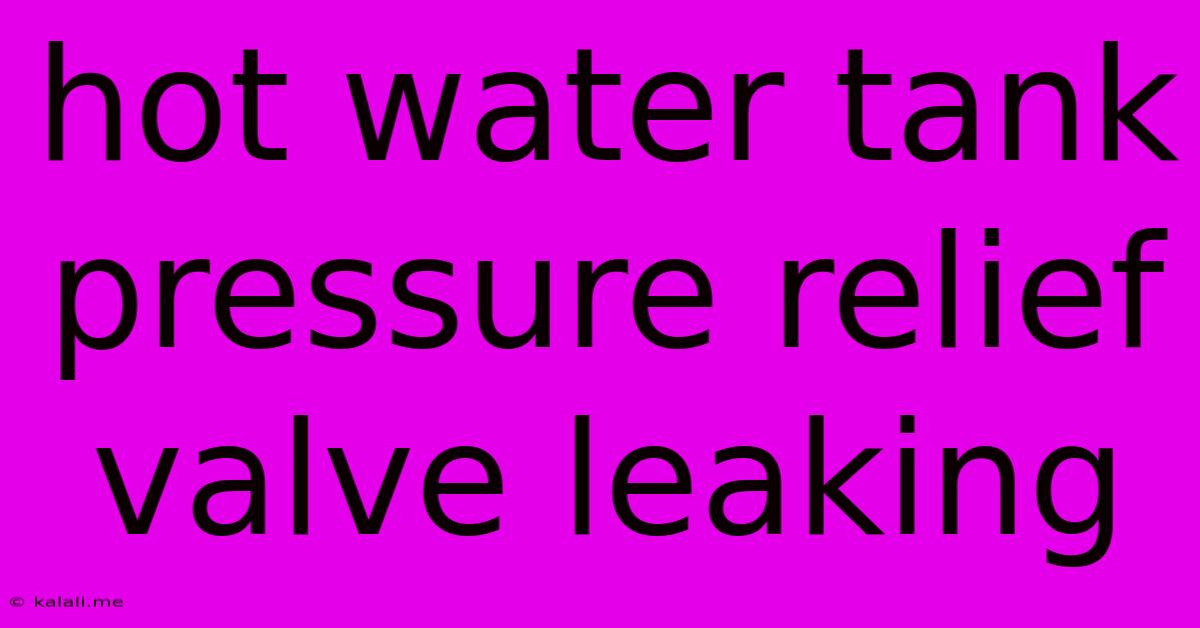Hot Water Tank Pressure Relief Valve Leaking
Kalali
May 25, 2025 · 4 min read

Table of Contents
Hot Water Tank Pressure Relief Valve Leaking: Causes, Solutions, and Prevention
A leaking hot water tank pressure relief valve is a serious issue that demands immediate attention. This article will guide you through understanding the causes of this problem, the steps to troubleshoot and fix it, and preventative measures to avoid future leaks. Ignoring a leaking pressure relief valve can lead to serious damage to your water heater, property, and even injury.
Understanding Your Pressure Relief Valve: Your hot water tank's pressure relief valve is a crucial safety device designed to release excess pressure and prevent explosions. It acts as a pressure release mechanism, venting hot water when the pressure inside the tank exceeds a safe limit. This excess pressure might be caused by a variety of issues, including a faulty temperature and pressure relief valve (T&P valve), a malfunctioning thermostat, or excessive water pressure from your main water line.
Why is My Pressure Relief Valve Leaking?
Several factors can contribute to a leaking hot water tank pressure relief valve. Here are some common causes:
- Excess Water Pressure: High water pressure from your main water line can easily exceed the valve's pressure threshold, triggering it to release water. This is often a consistent, slow drip rather than a sudden burst.
- Faulty Temperature and Pressure Relief Valve (T&P Valve): The valve itself may be faulty, damaged, or worn out. Mineral buildup, corrosion, or simple wear and tear can compromise the valve's sealing mechanism, leading to leaks. This is a common culprit and often requires valve replacement.
- Malfunctioning Thermostat: A faulty thermostat can cause the water in your tank to overheat, generating excessive pressure and activating the pressure relief valve. This often leads to more significant leaks, potentially with hot water.
- Sediment Buildup: Over time, sediment can build up in the bottom of your water heater, potentially restricting water flow and causing unusual pressure fluctuations.
- Overheating: If your water heater is overheating consistently, it will trigger the pressure relief valve. Check your thermostat settings and look for any issues with the heating element.
Troubleshooting and Repairing a Leaking Pressure Relief Valve
Before attempting any repairs, remember safety first! Turn off the power to your water heater and turn off the water supply to the tank. Allow the tank to cool completely before proceeding.
-
Check Water Pressure: Use a pressure gauge to measure the water pressure in your home's plumbing system. If it's consistently high (above 80 PSI), you need to address the main water pressure. A pressure regulator may be necessary.
-
Inspect the T&P Valve: Carefully examine the valve for any visible damage, corrosion, or mineral buildup. A slight drip may indicate minor wear, but a steady stream points to a serious problem.
-
Test the Valve (with caution): Gently lift the lever on the T&P valve. A small amount of water should release. If a large amount of water or steam is released, it signifies a problem and the valve likely needs replacement. Exercise extreme caution when doing this; hot water can cause serious burns.
-
Replace the T&P Valve (If Necessary): If the valve is damaged or leaking consistently, replacement is necessary. This usually involves simple unscrewing of the old valve and screwing in a new one of the correct pressure rating. Always choose a replacement valve with the same or slightly higher pressure rating.
-
Flush the Tank (Recommended): Once the new valve is installed, it's advisable to flush the water heater tank to remove sediment buildup. This can help prevent future pressure issues.
Preventing Future Leaks
- Regular Maintenance: Regularly inspect your T&P valve for leaks and corrosion. Consider an annual professional inspection of your water heater.
- Maintain Proper Water Pressure: Install a pressure regulator if your water pressure is consistently high.
- Regular Flushing: Flush your water heater tank at least once a year to remove sediment.
- Monitor Water Temperature: Ensure your water heater's thermostat is set to the appropriate temperature (typically around 120°F).
A leaking hot water tank pressure relief valve isn't something to take lightly. By understanding the causes, performing proper troubleshooting, and taking preventative measures, you can ensure the safety and longevity of your water heater. If you're uncomfortable performing repairs yourself, always call a qualified plumber.
Latest Posts
Latest Posts
-
Its No Fun When The Rabbit Has The Gun
May 25, 2025
-
How Do Hockey Players Know When To Sub
May 25, 2025
-
You Will Catch More Flies With Honey Than With Vinegar
May 25, 2025
-
Outside Ac Unit Blowing Cold Air
May 25, 2025
-
How To Describe Nervousness In Writing
May 25, 2025
Related Post
Thank you for visiting our website which covers about Hot Water Tank Pressure Relief Valve Leaking . We hope the information provided has been useful to you. Feel free to contact us if you have any questions or need further assistance. See you next time and don't miss to bookmark.